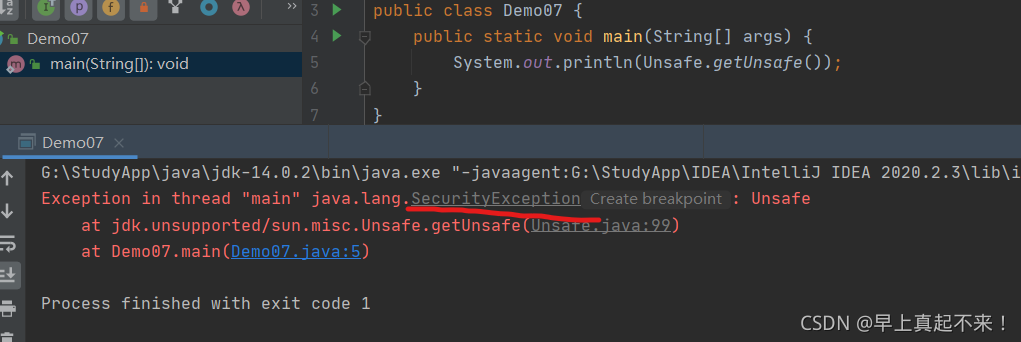简介
Unsafe为我们提供了访问底层的机制,这种机制仅供java核心类库使用,而不应该被普通用户使用。但是,为了更好地了解java的生态体系,我们应该去学习它,去了解它,不求深入到底层的C/C++代码,但求能了解它的基本功能。
获取Unsafe的实例
可以看到Unsafe仅供java内部类使用
private Unsafe() {} // 私有构造
private static final Unsafe theUnsafe = new Unsafe(); // 私有的Unsafe对象属性
查看Unsafe的源码我们会发现它提供了一个getUnsafe()的静态方法
@CallerSensitive
public static Unsafe getUnsafe() {
Class<?> caller = Reflection.getCallerClass();
if (!VM.isSystemDomainLoader(caller.getClassLoader()))
throw new SecurityException("Unsafe");
return theUnsafe;
}
如果直接调用这个方法会抛出一个SecurityException异常,这是因为Unsafe仅供java内部类使用,外部类不应该使用它

我们可以用反射,上面我们知道它有一个属性叫theUnsafe,我们直接通过反射拿到它即可。反射不理解可以参考Java反射.pptx
public static void main(String[] args) throws Exception {
Field f = Unsafe.class.getDeclaredField("theUnsafe");
f.setAccessible(true);
Unsafe unsafe = (Unsafe)f.get(null);
System.out.println(unsafe.getClass());
// 输出class sun.misc.Unsafe
}
使用Unsafe实例化一个类
class User {
int age;
public User(){
this.age = 10;
}
}
/**
* 如果我们通过构造方法实例化这个类,age属性将会返回10。
*/
User user1 = new User();
// 输出10
System.out.println(user1.age);
================================================
/**
* 如果我们调用Unsafe来实例化呢?
*/
User user2 = (User) unsafe.allocateInstance(User.class);
// 打印0
System.out.println(user2.age);
age将返回0,因为 Unsafe.allocateInstance()只会给对象分配内存,并不会调用构造方法,所以这里只会返回int类型的默认值0。
修改私有字段的值
使用Unsafe的putXXX()方法,我们可以修改任意私有字段的值。
/**
* User类
*/
class User {
private int age;
public User(){
}
public int getAge(){
return age;
}
}
/**
* 原来的反射修改私有属性的方法
*/
public static void main(String[] args) throws Exception {
Field f1 = User.class.getDeclaredField("age");
User user = User.class.getConstructor().newInstance();
f1.setAccessible(true);
f1.set(user,10);
}
// 输出10
System.out.println(f1.getInt(user));
/**
* 使用Unsafe
*/
public static void main(String[] args) throws Exception {
User user = User.class.getConstructor().newInstance();
Field age = user.getClass().getDeclaredField("age");
unsafe.putInt(user,unsafe.objectFieldOffset(age),20);
// 输出20
System.out.println(user.getAge());
}
一旦我们通过反射调用得到字段age,我们就可以使用Unsafe将其值更改为任何其他int值
抛出checked异常
我们知道如果代码抛出了checked异常,要不就使用try…catch捕获它,要不就在方法签名上定义这个异常,但是,通过Unsafe我们可以抛出一个checked异常,同时却不用捕获或在方法签名上定义它。
// 使用正常方式抛出IOException需要定义在方法签名上往外抛
public static void readFile() throws IOException {
throw new IOException();
}
// 使用Unsafe抛出异常不需要定义在方法签名上往外抛
public static void readFileUnsafe() {
unsafe.throwException(new IOException());
}
使用堆外内存
如果进程在运行过程中JVM上的内存不足了,会导致频繁的进行GC。理想情况下,我们可以考虑使用堆外内存,这是一块不受JVM管理的内存。
使用Unsafe的allocateMemory()我们可以直接在堆外分配内存,这可能非常有用,但我们要记住,这个内存不受JVM管理,因此我们要调用freeMemory()方法手动释放它。
假设我们要在堆外创建一个巨大的int数组,我们可以使用allocateMemory()方法来实现
class OffHeapArray { // 一个int等于4个字节
private static final int INT = 4;
private long size;
private long address;
private static Unsafe unsafe;
static {
try {
Field f = Unsafe.class.getDeclaredField("theUnsafe");
f.setAccessible(true);
unsafe = (Unsafe) f.get(null);
} catch (NoSuchFieldException e) {
e.printStackTrace();
} catch (IllegalAccessException e) {
e.printStackTrace();
}
}
// 构造方法,分配内存
public OffHeapArray(long size){
this.size = size;
// 参数在堆外存的字节数
address = unsafe.allocateMemory(size*INT);
}
// 设置指定索引处的元素
public void set(long i , int value){
unsafe.putInt(address+i*INT,value);
}
// 获取指定索引处的元素
public int get(long i){
return unsafe.getInt(address+i*INT);
}
// 释放堆外内存
public void freeMemory(){
unsafe.freeMemory(address);
}
}
在构造方法中调用allocateMemory()分配内存,在使用完成后调用freeMemory()释放内存
public static void main(String[] args) throws Exception {
OffHeapArray off = new OffHeapArray(4);
off.set(1,2);
off.set(2,3);
off.set(3,4);
off.set(2,5);
off.set(0,6);
int sum = 0;
for (long i = 0; i < off.getSize(); i++) {
sum += off.get(i);
}
// 输出17
System.out.println(sum);
off.freeMemory();
}
最后,一定要记得调用freeMemory()将内存释放回操作系统
CompareAndSwap操作
也就是CAS
JUC下面大量使用了CAS操作,它们的底层是调用的Unsafe的CompareAndSwapXXX()方法。这种方式广泛运用于无锁算法,与java中标准的悲观锁机制相比,它可以利用CAS处理器指令提供极大的加速。
比如,我们可以基于Unsafe的compareAndSwapInt()方法构建线程安全的计数器。
class Counter{
private volatile int count = 0;
// 记录count字段的偏移量 用Unsafe获取
private static long offset;
// 获取Unsafe对象
private static Unsafe unsafe;
static {
try {
Field f = Unsafe.class.getDeclaredField("theUnsafe");
f.setAccessible(true);
unsafe = (Unsafe) f.get(null);
// 设置count偏移量,为了能让Unsafe对其操作
offset =unsafe.objectFieldOffset(Counter.class.getDeclaredField("count"));
} catch (NoSuchFieldException e) {
e.printStackTrace();
} catch (IllegalAccessException e) {
e.printStackTrace();
}
}
public void increment(){
int before = count;
// 失败了就重试直到成功为止
while (!unsafe.compareAndSwapInt(this,offset,before,before+1)) {
before = count;
}
}
public int getCount(){
return count;
}
}
在increment()方法中,我们通过调用Unsafe的compareAndSwapInt()方法来尝试更新之前获取到的count的值,如果它没有被其它线程更新过(这里就是偏移量的作用,如果偏移量发生改变就说明此线程在改count的时候被其他线程修改过,所以会失败,就会重新获取count的值,重新判断),则更新成功,否则不断重试直到成功为止。
public static void main(String[] args) throws Exception{
Counter counter = new Counter();
for (int i = 0; i < 100; i++) {
new Thread(new Runnable() {
@Override
public void run() {
for (int i1 = 0; i1 < 1000; i1++) {
counter.increment();
}
}
}).start();
}
// 为了防止main线程提前结束
Thread.sleep(2000);
// 输出100000
System.out.println(counter.getCount());
}
park/unpark
JVM在上下文切换的时候使用了Unsafe中的两个方法park()和unpark()。
-
当一个线程正在等待某个操作时,JVM调用Unsafe的park()方法来阻塞此线程。
-
当阻塞中的线程需要再次运行时,JVM调用Unsafe的unpark()方法来唤醒此线程。
总结
使用Unsafe几乎可以操作一切:
(1)实例化一个类;
(2)修改私有字段的值;
(3)抛出checked异常;
(4)使用堆外内存;
(5)CAS操作;
(6)阻塞/唤醒线程;
扩展
论实例化一个类的方式?
(1)通过构造方法实例化一个类;
(2)通过Class实例化一个类;
(3)通过反射实例化一个类;
(4)通过克隆实例化一个类;
(5)通过反序列化实例化一个类;
(6)通过Unsafe实例化一个类;
public class Demo8 {
private static Unsafe unsafe;
static {
try {
Field f = Unsafe.class.getDeclaredField("theUnsafe");
f.setAccessible(true);
unsafe = (Unsafe) f.get(null);
} catch (NoSuchFieldException e) {
e.printStackTrace();
} catch (IllegalAccessException e) {
e.printStackTrace();
}
}
public static void main(String[] args) throws Exception{
/**
* 通过构造方法
*/
Student s1 = new Student();
/**
* 通过Class实例化一个类
*/
Student s2 = Student.class.newInstance();
/**
* 通过反射实例化一个类
*/
Student s3 = Student.class.getConstructor().newInstance();
/**
* 通过克隆实例化一个类
*/
Student s4 = (Student) s3.clone();
/**
* 通过反序列化实例化一个类
*/
Student s5 = unserialize(s4);
/**
* 通过Unsafe实例化一个类
*/
Student s6 = (Student) unsafe.allocateInstance(Student.class);
System.out.println(s1);
System.out.println(s2);
System.out.println(s3);
System.out.println(s4);
System.out.println(s5);
System.out.println(s6);
/*
Student@6d21714c
Student@108c4c35
Student@4ccabbaa
Student@5f4da5c3
Student@4bf558aa
Student@2d38eb89
*/
}
public static Student unserialize(Student student) throws Exception{
ObjectOutputStream output = new ObjectOutputStream(new FileOutputStream("D://a.txt"));
output.writeObject(student);
output.close();
ObjectInputStream input = new ObjectInputStream(new FileInputStream("D://a.txt"));
Student student1 = (Student)input.readObject();
input.close();
return student1;
}
}
class Student implements Cloneable,Serializable {
private int age;
public Student(){
this.age = 10;
}
@Override
protected Object clone() throws CloneNotSupportedException {
return super.clone();
}
}